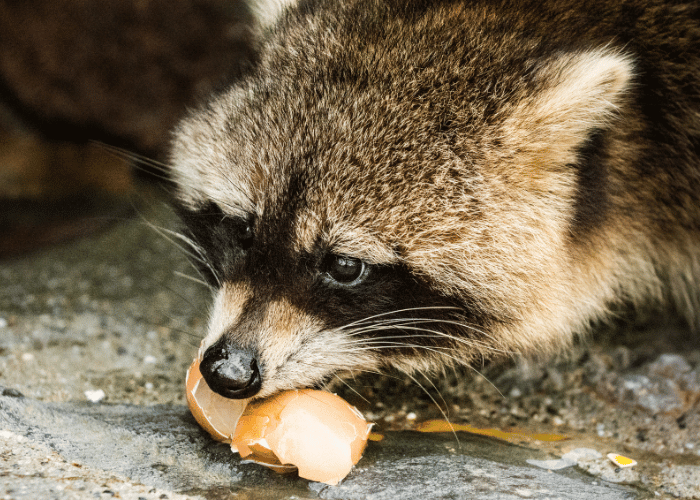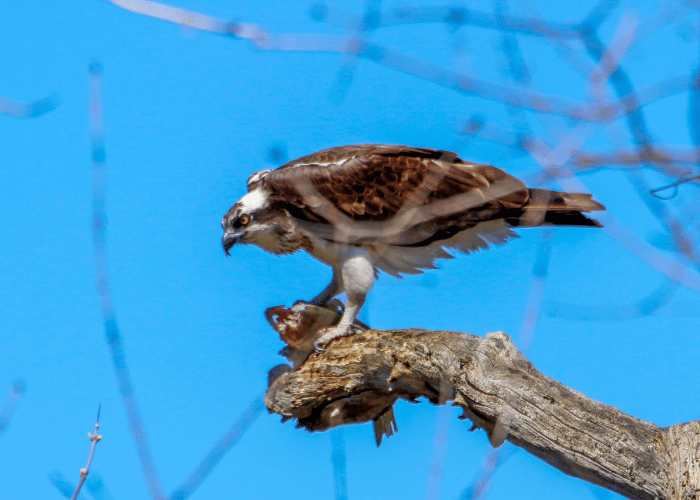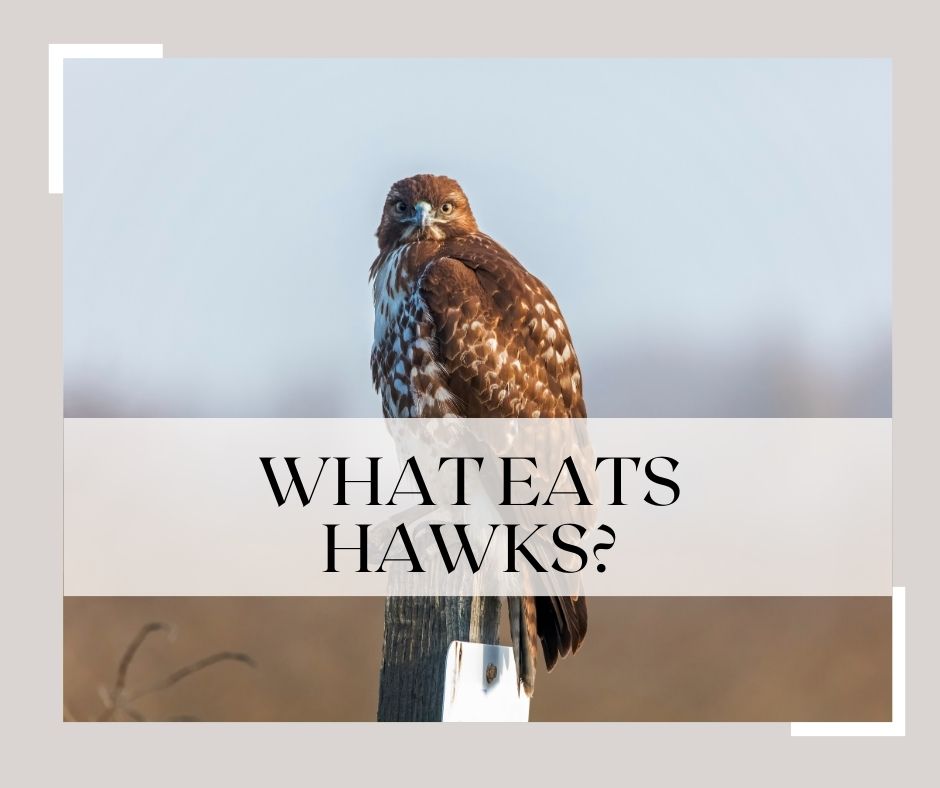What Eats Hawks
Table of Contents
Well, I was watching this hawk fly in the sky the other day, and it got me wondering: “What on earth would or could eat a hawk?” It seems incredible, doesn’t it? Those mighty wings, sharp talons, and that fierce beak. Who could possibly take on these fiery fowl? I mean, they’re top of the food chain, right?
Guess what? I found out that hawks aren’t invincible and actually have a couple of natural predators. However, it’s not a long list. These predators are called apex predators, because they sit nice and comfy on top of everyone else in the pyramid (food pyramid, that is!).
Before we jump into it, I’ll just clarify, when I bring up the term “hawk”, I’m generally referring to medium-sized birds of prey, a part of the diverse family Accipitridae. Now let’s dive into this fascinating world of predator-prey relationships, where even the sky isn’t a safe haven.

Raptor Predators: Who’s Hungry for Hawks?
You might think to yourself, “What beast of prey could possibly take down a hawk?” Well, hold onto your hats folks, it’s not just one, but several animal species that won’t say no to a little hawk for dinner!
Let’s kick off with owls. Yeah, I know, hard to believe! Owls and hawks might seem like birds of a feather (pun intended), but it’s actually quite common for large owl species, such as the Great Horned Owl, to snack on their own kind. Talk about harsh!
Of course, we can’t forget our four-legged friends, raccoons. If they stumble upon an unguarded hawk nest, they won’t hesitate to help themselves to eggs or nestlings. Those little bandits will pretty much take anything they can get their paws on!
Moving up the food chain, eagles rank high on the list of hawk predators. Majestic Bald Eagles, for instance, won’t pass up the opportunity to grab a tasty hawk. Bigger size and more powerful claws make it a real threat to hawks of all sizes.
| Predators | Prey |
|---|---|
| Owls | Hawks |
| Raccoons | Hawk eggs/nestlings |
| Eagles | Hawks |
Then there are those animals that you might not immediately think of, like large fish such as the Northern Pike. Hawks gotta drink, right? And when they do, they sometimes end up on the menu. Yeah, I was shocked too.
Lastly, but certainly not least, let’s not forget the most unpredictable creatures in the animal kingdom – us! Or, more specifically, humans. Sure, we might not eat hawks, but human activity can be a real danger to these magnificent raptors. Be it habitat destruction or poisoning, humans can, and sadly often do, take down hawks.
Fascinating, isn’t it? There’s a lot happening out there in the wild. So let’s always remember to tread lightly, because everyone deserves a fighting chance in the great circle of life!
The Circle of Life: Hawks as Prey
Despite their reputation as fierce predators, hawks don’t sit at the top of the food chain. Isn’t it surprising? Sure, hawks are known for their powerful build and swift hunting skills but out there in the wild, they also become a meal.
So who eats hawks? Well, the answer might surprise you. A big predator here is the great horned owl. You heard me right, an owl. Owls are nocturnal creatures, meaning they’re active at night when the hawks are settling in for rest. They take advantage of this opportunity to swoop down and attack unsuspecting hawk nests.
Eagles don’t take a back seat in predation either. Eagles, especially the mighty Bald Eagles and Golden Eagles, have been known to prey on hawks. Their advantage is in their size; they’re bigger, stronger, and offer some stiff competition.
And let’s not forget our slithering friends. Believe it or not, the Great Plains Ratsnake also has hawks on its menu! These sneaky guys will climb trees to raid nests for tasty hawk eggs or chicks.
Now, to give you an idea of the scale of predation, let’s lay some numbers out.
| Predator | Estimated % of Hawks Eaten |
|---|---|
| Great Horned Owls | 60% |
| Eagles | 25% |
| Ratsnakes | 15% |
Oh, and humans. Yes, humans. We pose a threat too through poaching, habitat destruction, and those unintended collisions with our vehicles. Sad but true.
As daunting as it may sound, it’s all part of nature’s balance. Hawks prey on smaller animals, and in turn, they also become prey. It’s how the circle of life spins.

Specific Animals Known to Hunt Hawks
Never think that the food chain is just a one-way street! Hawks, majestic and fierce, have their share of natural predators too. It’s a surprise for many, but true. So let’s dive in and explore some of these creatures.
Critters on top of this predator’s threat list include the Great Horned Owls and Eagles. They’re similar in size or even larger, making them formidable opponents. Not just fellow birds, but Raccoons, sharp-clawed and crafty, are known to raid hawk nests and snack on their eggs. Survival in the wild is a harsh reality!
Let’s put some numbers into perspective. The table below shows a brief rundown:
| Predator | Average Number of Hawks Hunted per Year |
|---|---|
| Great Horned Owls | 50+ |
| Eagles | 30+ |
| Raccoons | 100+ (eggs) |
Larger fellow raptors like the Golden Eagles and Bald Eagles are a threat too. Eagles possess sharp talons and greater strength, so a stop-over in eagle territories can turn out fatal for hawks.
Rarely, yet realistically, the adaptable Red Fox can become a hawk’s nightmare. If a hawk is injured or grounded, these cunning hunters don’t miss the opportunity.
On the other side of the spectrum, even humans pose a threat, intentionally or unintentionally. Hawks get entangled in barbed wire fences or are victims of illegal shooting.
Mentioning smaller threats, snakes and even large squirrels have been known to invade hawk’s nests when the opportunity presents itself.
Above all, it’s essential to note the role of the survival game and natural balance. This dynamic interplay between species is what keeps our ecosystems vibrant and alive. After all, even the predators have predators, don’t they?
Unusual Suspects: Non-Predators That Pose Risks to Hawks
Have you considered what non-predatory threats hawks face? It’s not just the monsters of the sky they have to worry about, but sometimes it’s the seemingly innocent creatures that pose a risk too. Let’s dive into this.
Believe it or not, squirrels are one of these threats. Yes, those bushy-tailed creatures. While hawks do often prey on squirrels, these furry acrobats can fight back. Sometimes, they manage to inflict serious injuries with their sharp claws and teeth.
Another surprising risk comes from raccoons. These nocturnal scavengers are opportunists who wouldn’t mind raiding a hawk’s nest for a quick snack. They’re agile climbers, making it easy for them to reach nests in trees or on cliffs.
Last but not least, let’s talk about humans. I know it’s kind of a downer, but we pose a huge threat to hawks. From habitat destruction to accidental poisonings, the dangers that we, humans, pose to hawks are numerous and multifaceted.
Here’s a simplified breakdown for you:
| Non-predatory Threat | How Does It Threaten Hawks |
|---|---|
| Squirrels | Inflict serious injuries during a fight or an attempted predation |
| Raccoons | Raid hawk’s nests and consume eggs or hatchlings |
| Humans | Cause habitat loss, poisonings and illegal hunting |
Remember, the universe of threats for hawks isn’t limited to natural predators. Life as a hawk is challenging and fraught with dangers from surprising sources. I hope this gives you a new perspective on the lives of these majestic birds. Nature is indeed a complex and intricate web of interactions!
Stay tuned for the next section, where I’ll discuss strategies for protecting and conserving hawks.
Threats to Hawks: Understanding Nature’s Balance
We often see majestic hawks soaring high in the sky, don’t we? Have you ever stopped to think, “What could possibly pose a threat to these fierce birds?” Well folks, it turns out that hawks have a number of predators to be wary of too! Yes indeed, even these regal birds of prey need to watch their backs.
First up, let’s talk great horned owls. You may not think of these nocturnal creatures as threats to hawks, but they’re actually one of their main predators. See, these owls share the same habitats and food preferences as hawks, leading to strong competition. And sometimes, that competition goes beyond just a squabble over lunch.
Another surprising predator? Eagles. Larger and stronger, eagles can be a serious threat to smaller hawks. They’re known to hassle and harry hawks, percising them to drop their prey or even knocking them out of the sky! Can you believe it?
Of course, it’s not just other birds hawks have to worry about. When they’re young and vulnerable, hawks can fall prey to several ground-dwelling critters. From raccoons clawing their way up into the nests to foxes snatching up fledglings that have strayed too far, it’s a tough world out there.
And let’s not forget us humans. Unintentional or not, we pose a lot of threats to hawks. Be it habitat loss due to urbanization, or direct harm from hunting and trapping, these human-induced threats can have a significant impact on hawk populations.
Just to put things in perspective, here’s a rundown of the main predators of hawks:
- Great horned owls
- Eagles
- Ground-dwelling animals like raccoons and foxes
- Humans
Let’s remember, nature is all about balance. Every creature, big or small, has its place in the grand scheme of things. One organism’s survival often depends on intricately intertwined relationships with others. I reckon that’s something we could all do well to remember. Hawks included, of course!

Concluding Thoughts on the Hawk Food Chain
Well, we’ve gotten to the end of this fascinating journey exploring what eats hawks. It’s been a thrill discussing the hawk food chain with you, and I hope it’s opened your eyes to the intricate web that connects even the most formidable predators to the ecosystem.
From my research and observation, it’s remarkable to see that even the incredible hawks are not invincible. Deep down in their world, they have potential predators including great horned owls, bald eagles, and even larger hawks.
Let’s not forget, however, that this isn’t just about who eats who in this food hierarchy. It’s about an interconnected system. What affects one species, in turn, affects several others. A reduction in the hawk population wouldn’t just cause an increase in the populations of their prey, but also stress upon the creatures who rely on hawks as a part of their diet.
Here is a quick rundown of the hawk’s known predators:
- Great Horned Owl: A fearsome predator to both young and adult hawks.
- Bald Eagles: Mainly a threat to young hawks.
- Larger Hawks: Yes, hawks can potentially eat other smaller hawks.
It’s essential to note that hawks’ role goes beyond being prey or predator. They’re crucial members of our environment, acting as both seed dispensers and rodent control, and even more than that. And remember, the hawk food chain doesn’t end with the great horned owl or the bald eagle. It continues upwards, with mankind arguably being atop, affecting all creatures beneath, hawks included.
To wrap things up, I hope this exploration into the world of hawks has provided you with a deeper appreciation for these fascinating birds and their place in the food chain. We’re all part of this intricate web of life, and understanding the role each creature plays helps us navigate our path in preserving this beautiful balancing act. So, the next time you see a hawk soaring in the sky, remember the part it plays in the grand scheme of things.
Isn’t nature brilliant? I think so, how about you?






